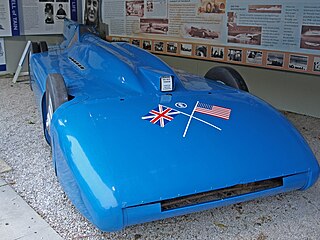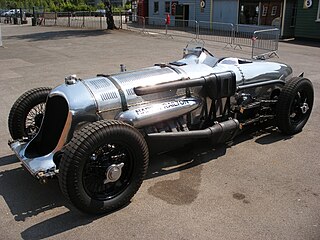
Major Sir Malcolm Campbell was a British racing motorist and motoring journalist. He gained the world speed record on land and on water at various times, using vehicles called Blue Bird, including a 1921 Grand Prix Sunbeam. His son, Donald Campbell, carried on the family tradition by holding both land speed and water speed records.

Pendine Sands is a 7-mile (11 km) beach on the shores of Carmarthen Bay on the south coast of Wales. It stretches west to east from Gilman Point to Laugharne Sands. The village of Pendine is close to the western end of the beach.

Sunbeam Motor Car Company Limited was a British automobile manufacturer in operation between 1905 and 1934. Its works were at Moorfields in Blakenhall, a suburb of Wolverhampton in Staffordshire, now West Midlands. The Sunbeam name had originally been registered by John Marston in 1888 for his bicycle manufacturing business. Sunbeam motor car manufacture began in 1901. The motor business was sold to a newly incorporated Sunbeam Motor Car Company Limited in 1905 to separate it from Marston's pedal bicycle business; Sunbeam motorcycles were not made until 1912.

John Godfrey Parry-Thomas was a Welsh engineer and motor-racing driver who at one time held the land speed record. He was the first driver to be killed in pursuit of the land speed record.

Chitty Bang Bang was the informal name of a number of celebrated British racing cars, built and raced by Count Louis Zborowski and his engineer Clive Gallop in the 1920s, which inspired the book, film and stage musical Chitty-Chitty-Bang-Bang.

The Railton Special, later rebuilt as the Railton Mobil Special, is a one-off motor vehicle designed by Reid Railton and built for John Cobb's successful attempts at the land speed record in 1938.

The Sunbeam 1000 HP Mystery, or "The Slug", is a land speed record-breaking car built by the Sunbeam car company of Wolverhampton that was powered by two aircraft engines. It was the first car to travel at over 200 mph. The car's last run was a demonstration circuit at Brooklands, running at slow speed on only one engine. It is today on display at the National Motor Museum, Beaulieu.
The British land speed record is the fastest land speed achieved by a vehicle in the United Kingdom, as opposed to one on water or in the air. It is standardised as the speed over a course of fixed length, averaged over two runs in opposite directions.

Golden Arrow is a land speed record racer that was built in Britain to regain the world land speed record from the USA. Henry Segrave drove the car at 231.45 mph (372.46 km/h) in March 1929 on Daytona Beach, exceeding the previous record by 24 mph (39 km/h).

Thunderbolt was a British Land Speed Record holder of the 1930s, driven by Captain George E.T. Eyston.

The Bluebird-Proteus CN7 is a gas turbine-powered vehicle that was driven by Donald Campbell and achieved the world land speed record on Lake Eyre in Australia on 17 July 1964. The vehicle set the FIA world record for the flying mile at 403.1 mph (648.7 km/h).

The Napier-Campbell Blue Bird was a land speed record car driven by Malcolm Campbell. Its designer was C. Amherst Villiers and Campbell's regular mechanic Leo Villa supervised its construction.

The Campbell-Railton Blue Bird was Sir Malcolm Campbell's final land speed record car.

Babs was the land speed record car built and driven by John Parry-Thomas. It was powered by a 27-litre Liberty aero-engine.
The Sunbeam Tiger is a racing car, built by Sunbeam of Wolverhampton during the 1920s. It was the last car to be competitive both as a land speed record holder, and as a circuit-racing car.

The Sunbeam Matabele was a British 12-cylinder aero engine that was first flown in 1918. The Matabele was the last iteration of one of Sunbeam's most successful aero engines, the Cossack.

The Sunbeam Silver Bullet was the last attempt at the land speed record by Sunbeam of Wolverhampton. It was built in 1929 for Kaye Don. Powered by two supercharged engines of 24 litres each, it looked impressive but failed to achieve any records.

Jarvis & Sons Limited were South London-based motor dealers for Morris and MG, and latterly coachworks providing special bodies for various car chassis until after World War II.

An aero-engined car is an automobile powered by an engine designed for aircraft use. Most such cars have been built for racing, and many have attempted to set world land speed records. While the practice of fitting cars with aircraft engines predates World War I by a few years, it was most popular in the interwar period between the world wars when military-surplus aircraft engines were readily available and used to power numerous high-performance racing cars. Initially powered by piston aircraft engines, a number of post-World War II aero-engined cars have been powered by aviation turbine and jet engines instead. Piston-engined, turbine-engined, and jet-engined cars have all set world land speed records. There have also been some non-racing automotive applications for aircraft engines, including production vehicles such as the Tucker 48 and prototypes such as the Chrysler Turbine Car, Fiat Turbina, and General Motors Firebirds. In the late 20th century and into the 21st century, there has also been a revival of interest in piston-powered aero-engined racing cars.

The 1921 S.T.D. 'Works' Grand Prix chassis was built to the three-litre and minimum weight of 800 kilogrammes formula for that year's Indianapolis 500 and French Grand Prix de l’A.C.F. These team cars were modified by the Sunbeam Experimental department in Wolverhampton for the 1922 Isle of Man Tourist Trophy, which was won by one of the cars. A few months later, and with 1916 4.9-litre engines, two of the T.T. cars competed in the Coppa Florio, Sicily and gained second and fourth position.



















